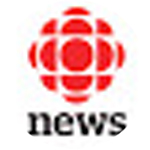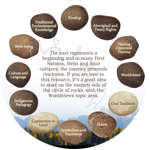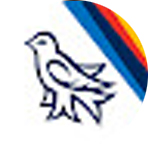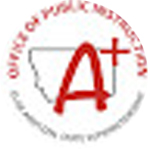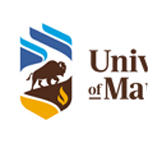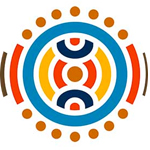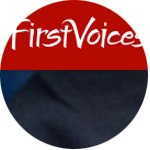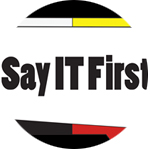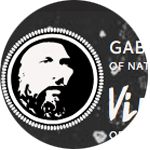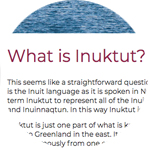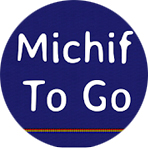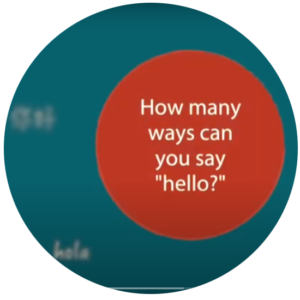Language
In this section, you will learn about Indigenous languages in what is now known as Alberta.
Introduction
Culture and language are intrinsically linked; language is culture. Language encapsulates worldview, teachings, identity, spirituality, history, ancestors, and connection to the land.1 Knowledge of the earth, land and how we live in balance with it is found in Indigenous languages.2 Language influences relationships. The authors of Naturalizing Indigenous Knowledge, Our Languages Guide Us in our Relationships (2007) state that “we understand the world in terms of relationships, so when others came to share our lands, we treated them as we would treat our relatives: according to our respect, kindness, generosity, and thoughtfulness.”3
Diverse Languages
Distinct and diverse Indigenous languages have been spoken across this land since time immemorial. There are three language family groups that are original to this land now known as Alberta: Algonquian, Athapaskan, and Siouan. The Algonquian language family group includes Nēhiyawēwin (Cree) and Siksikáí’powahsin (Blackfoot) which is inclusive of four nations Siksiká (Blackfoot), Aapátohsipikani (North Piikani), Aamsskáápipikani (South Piikani) and Kainai (Blood). Dene Sųłiné (Athapaskan) includes Dane-zaa (Beaver) originally spoken throughout the north as well as within the Tsuu t’ina (Sarcee) nation. The Siouan language family group within Alberta includes Nakoda (Stoney and Assiniboine). Many other Indigenous languages are also spoken in Alberta by Indigenous Peoples whose first language originates from other parts of Turtle Island.
Métis
Michif, the distinct language of the Métis, is spoken in Alberta and throughout the Métis homeland. Métis in Alberta speak two dialects of Michif: Heritage Michif, and
Northern Michif. As Rupertsland Institute explains in the Languages of Métis: Métis Foundational Knowledge Theme: “Multilingualism has long been an important attribute of Métis identity. Historically, Métis children across the Homeland learned Michif at home, often together with other languages, including nehiyawewin (Cree), English, or Français (French).”5
The Métis Nation of Alberta affirms this, sharing that:
The Michif language is a combination of French nouns and Cree verbs and is spoken by Métis in the provinces of Manitoba, Saskatchewan, Alberta, British Columbia, Ontario, and in the South Slave Region of the Northwest Territories. Depending on the region, the language spoken may be Michif-Anishnaabe or Michif-Cree. The highest numbers of Michif speakers are found in the Prairies. Many Métis people also speak Cree, which is more widely spoken than Michif.6
Inuit
Inuit Nunangat represents Inuit and Inuvialuit from all four northern regions. There are currently 9 writing systems across Inuit Nunangat. In efforts to maintain, protect and revitalize the language, a unified written system; Inuktut Qaliujaaqpait, was developed by Inuit representing each region across Inuit Nunangat. Inuktitut (Nunavut, Nunatsiavut, Nunavik) and Inuvialuktun (Northwest Territories) are the spoken languages in Inuit Nunangat Alaskan and Labradorian communities may not be able to easily communicate, although communities that are close in proximity can understand each other’s dialects.7 “Vocabulary and pronunciation vary from place to place and between generations. Up until 50 years ago, most Nunavut Inuit lived in isolated camps where distinct speech forms evolved. As they settled into permanent communities, speakers of varying dialects often became neighbours in the same hamlet. Today, fluent speakers in all parts of Nunavut can normally understand each other with only minor difficulties.
Decimating Languages
Prior to colonization there were close to 300 Indigenous languages spoken in what is now Canada with only 70 still spoken today.9 15.6 percent of the Indigenous population are able to conduct conversations in an Indigenous language, according to census data from Statistics Canada 2016.10 Aggressive assimilation policies and attitudes attempted to forcibly decimate Indigenous languages. In residential schools, Indigenous students were taught that their languages were inferior, unsophisticated and, in many cases, ‘evil.’ Spiritual, physical, mental, and emotional punishment was used to enforce the banning of Indigenous languages in residential and day schools. 11 Negative perceptions gave rise to justifications for devaluing Indigenous languages to the point where many Indigenous Peoples choose not to pass down their mother tongue for fear of harsh punishment, exclusion, and ostracization. The demeaning of Indigenous languages has resulted in generations of people who have been severely disconnected from inherent worldviews, connection to land, stories, and terms of endearment embedded in language.
The president of Nunavut Tunngavik Inc (NTI), Aluki Kotierk, states “Education in Nunavut has a history of cultural genocide, linguicide, ecocide and historicide, and this continues today.”12 According to a report done for NTI, Nunavut’s poor record in Inuit language education is related to many harms, including “ecocide” (making people poor); “historicide” (exclusion from history); “ecocide” (killing the environment) and “linguicide” (killing a language.) 13
Language Resurgence
Indigenous languages are resurging as concerted efforts are made to create accessible resources for language learners. There are books, apps, websites, videos, and posters readily available. Educators can make efforts to seek the original language of the land in which they are on and find opportunities to weave in language learning throughout subject areas. For example, there continue to be many original place names that are common to the average Albertan such as ‘Wetaskiwin’ which is Cree word derived from wītaskīwin-ispatinaw meaning ‘the hills where peace was made.’ Original place names are one way of connecting with Indigenous languages while celebrating the beauty and richness of the interconnectedness language has with the natural world and worldviews embedded in language. Seeking and teaching examples like this creates opportunities to learn about language origin, meaning, and story, which is one way of igniting deeper understandings of Indigenous languages and history. Stories from the Land is one resource to access when looking for language and land entry points. There are many ways to access, incorporate and celebrate the resilience of Indigenous languages. One of the most important is to develop relationships with local Indigenous language speakers who will help nurture reconciliation and provide entry points for further learning.
Survive and Thrive
Although many First Nations, Métis, and Inuit who attended residential schools and day schools were severely punished through extreme physical and emotional abuse for speaking their language, Indigenous Peoples and languages have survived.
Indigenous languages are sophisticated, beautiful, and rich. Educators need to be aware of the connection between culture, language, and identity. Language connects people to families, history, ancestors, Elders, knowledge keepers, stories, and land.14 Presently, community-based programs are making strides in language revitalization. Within education systems, the movement towards immersion is backed by research showing that immersion is the most effective method for language acquisition.15 On the world stage, the United Nations declared 2019 the International Year of Indigenous Languages, stating that Indigenous languages “matter for development, peacebuilding, and reconciliation.”16 The sentiment continues beyond the scope of 2019 and, with renewed focus moving forward, Indigenous languages will thrive and flourish.
2022-2032 has been declared the Decade of Indigenous Languages by United Nations Educational, Scientific and Cultural Organization (UNESCO) . The declaration emphasizes the dire need to preserve, revitalize and promote Indigenous languages at national and international levels. The declaration also emphasizes the necessity to use Indigenous languages within systems such as judicial, media, labour, health, and education. 17
Indigenous Languages in Education
Alberta Education has acknowledged the importance of preserving, maintaining, strengthening, and revitalizing Indigenous languages. Several districts have developed and implemented Indigenous language and culture programming.
Reflection
1. What Indigenous languages are spoken or taught in the communities in your jurisdiction?
2. How can you engage with Indigenous language speakers to demonstrate the value of and support the delivery of Indigenous languages within your jurisdiction?
3. What funds, policies, and procedures are in place to support language learning within your jurisdiction?
4. How has or can your jurisdiction implement language and cultural programming and what are you doing to measure its impact on moving forward in reconciliation?
5. One small action that I/we (leadership team) take is ……
Related Resources
This document provides some background on the systematic taking of Indigenous languages as well as wise practices for language revitalization.
An interactive map featuring place names, translations and dialects across what is now Canada
Husband and wife, the Late Narcisse Blood and Alvine Mountain Horse, speak in Blackfoot about how knowledge of land is considered sacred and the connection between land and language.
A visual representation of 2016 census data showing Indigenous languages spoken across Canada.
As co-chair of a Curriculum First Nations, Métis and Inuit Advisory Committee meeting, Wayne Jackson speaks about the importance of preserving the Cree language and culture.
Elder Mary Cardinal-Collins speaks on kinship through the Cree language.
This video provides tips for those who do not speak Indigneous languages to support Indigenous language revitalization.
Explore Heritage Michif Lesson plans created by Métis Educators for grades K-9. The interactive activities will help educators build their foundational knowledge about the Michif language while engaging and introducing students to a unique Indigenous Language.
Narcisse Blood speaks to the connection between language and worldview from a Blackfoot perspective.
A young man from the Siksika Nation has started his own clothing line in order to generate revenue to support language revitalization among youth in his community.
This article explores the role of public schools in supporting the revitalization of Indigenous languages.
This article reports on Tsuut’ina language classes aimed at language revitalization. The classes were taught by Tsuut’ina Language Commissioner Elder Bruce Starlight, who shared that, “Our language is holy, it was given by the [C]reator.”
This article delves into some of the complexities around original Indigenous place names, and the erasure that has occured since contact.
This podcast explores the wide range of initiatives that are in place aimed at Indigenous language revitalization.
The United Nations’ website for the International Year of Indigenous Languages features information about the importance of Indigenous languages as well as links to further resources.
First Voices is a suite of web-based tools and services designed to support Indigenous People engaged in language archiving, language teaching and culture revitalization.
ASBA Indigenous Advisory Circle Elders discuss how identity is tied to language and how important the teaching of Indigenous languages is for young people.
A web page dedicated “To use technology and community participation to Modernize, Expand, Revitalize and Localize (MERL) Indigenous languages in Canada, and to help our First Nations, Métis, and Inuit (FNMI) communities produce more language speakers tomorrow than exist today.”
The Gabriel Dumont Institute (GDI) works with Michif speakers to preserve and promote the three Michif languages spoken in Saskatchewan: Michif, Michif-French, and Northern Michif.
A comprehensive downloadable pdf that build foundational knowledge of Metis Language
Rupertsland Centre for Teaching and Learning RCTL YouTube Videos Children’s books read in French, English, Cree, & French for Read-In Week
Who are the Métis? Video MNA Vice-President Dan Cardinal speaks to the relationship of Métis language and identity.
A comprehensive guide featuring links to a variety of Indigenous related resources
Resources to support the study of the International Year of Indigenous Languages as well as exploring Canadian Indigenous languages.
A new interactive project from Google Earth. Launched in August 2019, this project features audio recordings of more than 50 different Indigenous languages from around the world. For each language, visitors can listen to a traditional greeting and two other examples of the language (e.g. common phrases or songs).
This video from the University of Victoria describes five easy ways to support Indigenous people in your community working to revive their languages
Data on people in Canada who identified as Indigenous language speakers in the 2016 census.
Footnotes
| 1 | Linguistic Ideologies of Native American Language Revitalization: Doing the Lost Language Ghost Dance. David Leedom Shaul. Springer, 2014. P. 3 |
| 2 | Makokis, L.J., Shirt, M.v., Chisan, S.L., Mageau, A.Y., Steinhauer, D.M., mâmawi-nehiyaw iyinikahiwewin. Retrieved from http://www.bluequills.ca/wp-content/uploads/2017/03/BQ_SSHRC_2010_final_report.pdf |
| 3 | Leona Makokis, Diana Steinhauer, James Lamouche “Naturalizing Indigenous Knowledge, Our Languages Guide Us in our Relationships”, (Blue Quills FN College, St. Paul, Alberta, 2007) |
| 4 | Rupertsland Institute, Languages of Métis: Foundational Knowledge Themes, (Edmonton: Rupertsland Institute, 2021 |
| 5 | Métis Nation of Alberta. “The Métis Language” Michif.” Retrieved from https://albertametis.com/culture/language/ |
| 6 | Inuktut Tusaalanga. “What is Inuktut?” Website https://tusaalanga.ca/node/2502 |
| 7 | ibid |
| 8 | ibid |
| 9 | Statistics Canada. “The Aboriginal Languages of First Nations People, Métis and Inuit.” Statistics Canada. https://www12.statcan.gc.ca/census-recensement/2016/as-sa/98-200-x/2016022/98-200-x2016022-eng.cfm. |
| 10 | ibid |
| 11 | Truth and Reconciliation Commission of Canada. Final Report of the Truth and Reconciliation Commission of Canada, Vol. 1: Summary. Honouring the Truth, Reconciling for the Future (Toronto: James Lorimer & Company, Ltd., Publishers, 2015), 1–6 and 83–87. Retrieved from www.trc.ca/ websites/trcinstitution/File/2015/Findings/ Exec_Summary_2015_05_31_web_o.pdf. |
| 12 | Palmater, Pamela. “Genocide, Indian Policy, and Legislated Elimination of Indians in Canada.” Aboriginal Policy Studies. Vol. 3, no. 3, 2014: 28. Retrieved from https://journals.library.ualberta.ca/aps/index.php/aps/article/view/22225/pdf_22 |
| 13 | Bell, J. April 2019. Nunatsiq News. Nunavut’s education system “constitutes cultural genocide,” says Inuit org https://nunatsiaq.com/stories/article/nunavuts-education-system-constitutes-cultural-genocide-says-inuit-org/ |
| 14 | Skutnabb-Kangas, T., Phillipson, R., Dunbar, R., nd. Is Nunavat Education Criminally Inadequate? An analysis of current policies for Inuktut and English in Education, international and nation law,linguistic and cultural genocide and crimes against humanity. https://www.tunngavik.com/files/2019/04/NuLinguicideReportFINAL.pdf |
| 15 | Report on the Status of B.C. First Nations Languages 2010. http://www.fpcc.ca/language/status-report/ First Peoples’ Heritage, Language and Culture Council Language Program. Language and Culture Immersion Programs Handbook. Retrieved from http://www.fpcc.ca/files/PDF/language-immersion-handbook.pdf |
| 16 | International Year of Indigenous Languages 2019. Website: https://en.iyil2019.org/ |
| 17 | United Nations Educational, Scientific and Cultural Organization (UNESCO) https://en.unesco.org/news/upcoming-decade-indigenous-languages-2022-2032-focus-indigenous-language-users-human-rights |

